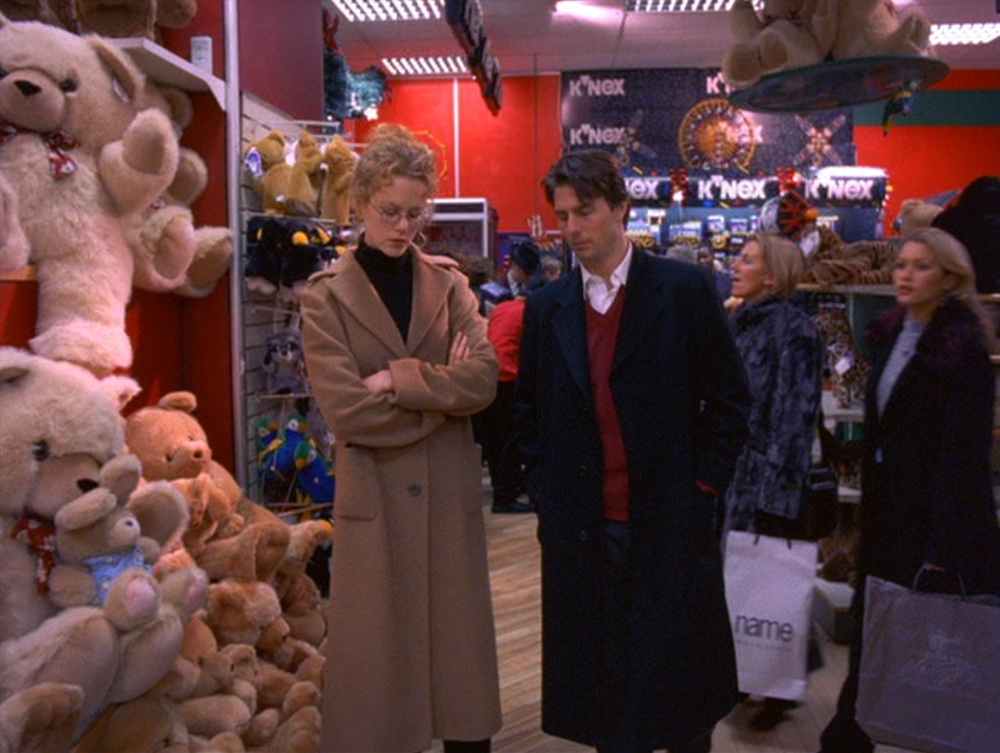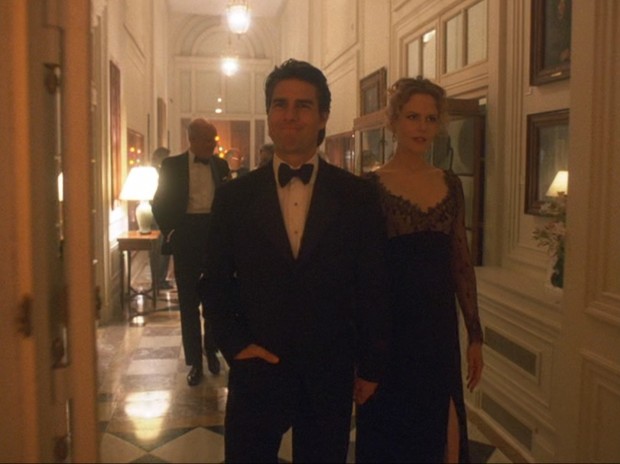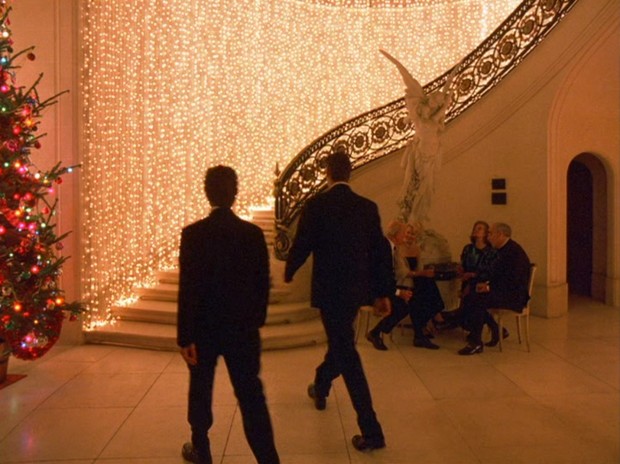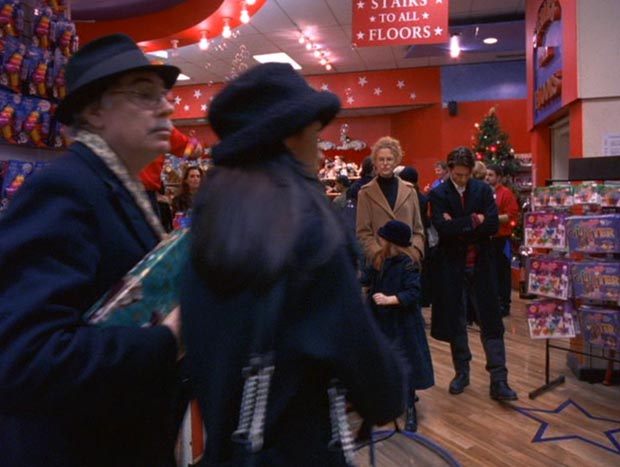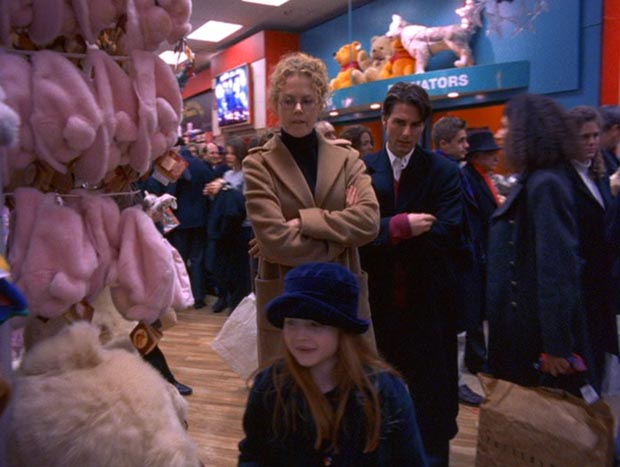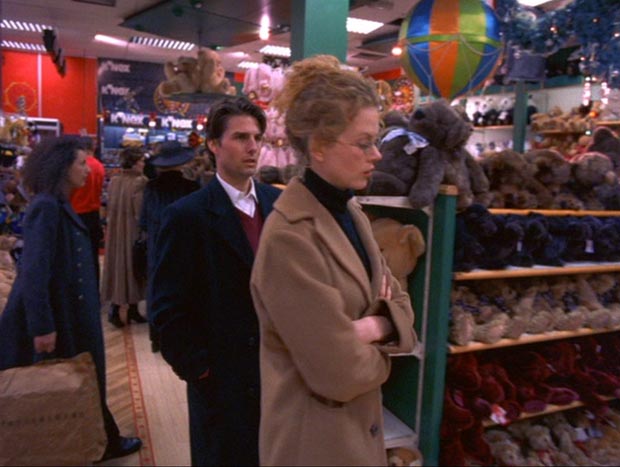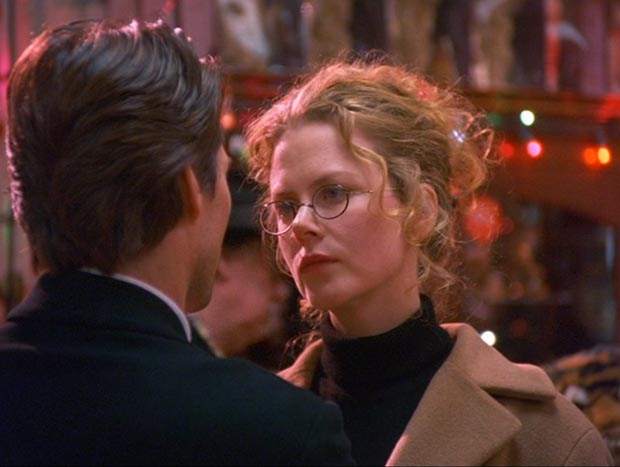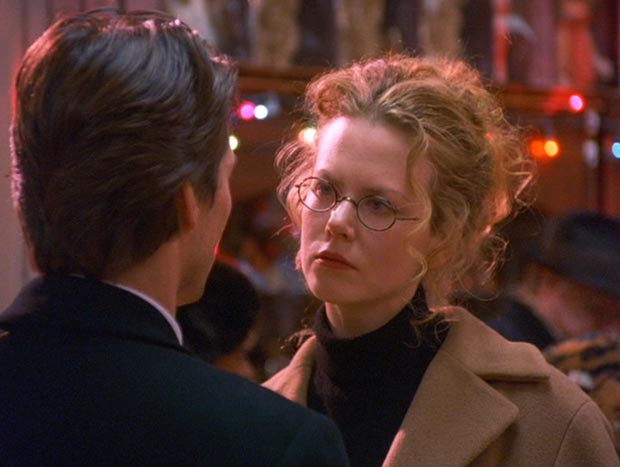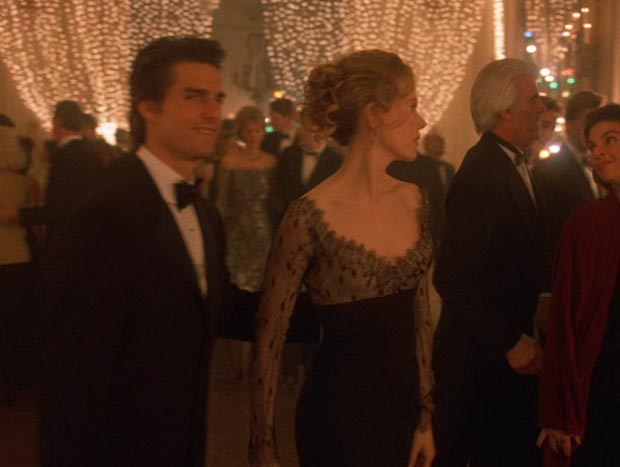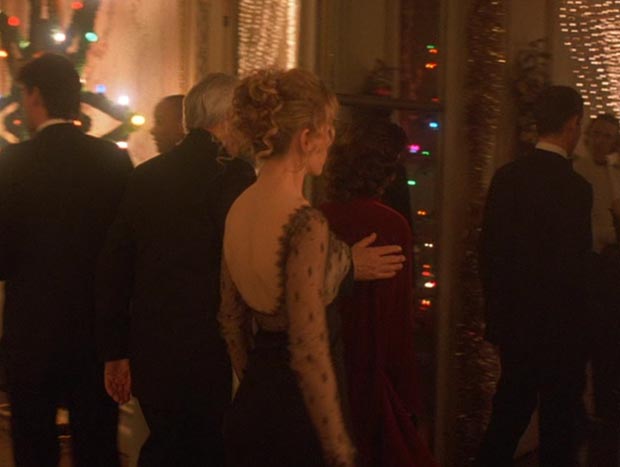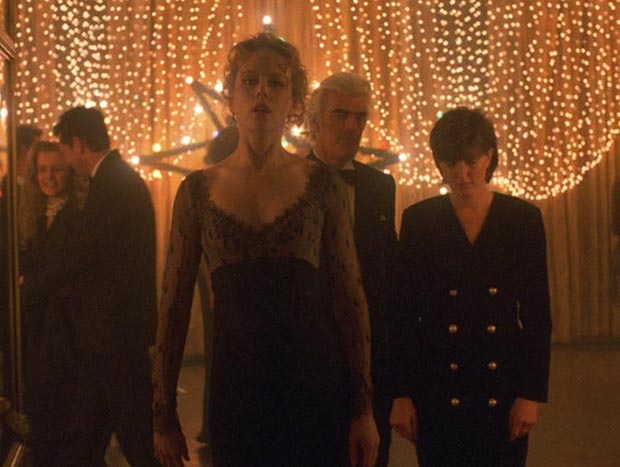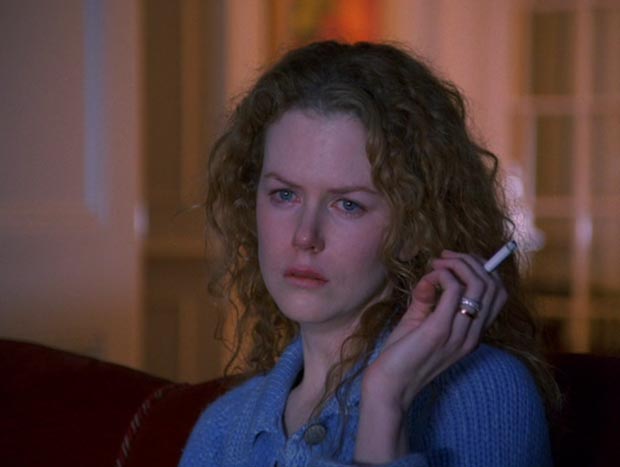STANLEY KUBRICK'S EYES WIDE SHUT

Go to TOC for this film ( (which has also a statement on purpose and manner of analysis and a disclaimer as to caveat emptor and my knowing anything authoritatively, which I do not, but I do try to not know earnestly, with some discretion, and considerable thought).
PART NINE
TOC and Supplemental Posts | Part 1 | Part 2 | Part 3 | Part 4 | Part 5 | Part 6 | Part 7 | Part 8 | Part 9 | Films Home
LINKS TO SECTIONS OF THE ANALYSIS ON THIS PAGE:
Helena Expects to go Christmas Shopping, Shots 568 through 573
The Magic Circle, Shots 574 through 587
Eyes Wide Shut as a process of awakening through the initiatory, inward journey aspects of the maze
The Oracle
Helena's Exit
HELENA EXPECTS TO GO CHRISTMAS SHOPPING
SKIP ALL THIS AND TAKE ME TO THE TL;DR WRAP-UP AT THE END OF THE PAGE.
568 MCU Alice in the living room. (2:27:41)
Cut to Alice, smoking, dressed in a blue sweater, eyes red with tears, sitting on the sofa. Sounds of the daylight city outside.
569 MS Bill on the opposite sofa. (2:27:54)
570 MCU Alice. (2:28:01)
571 MCU Bill. (2:28:14) He doesn't look at her but stares at the ground. He raises his hand to his face, stifling tears.
572 MCU Alice. (2:28:26)
ALICE: Helena's going to be up soon. She's uh...she's expecting...
573 MCU Bill. (2:28:51)
ALICE: ...us to take her Christmas shopping today.
NOTE: Thanks to David for the following info. "After Bill comes home to find the mask on the bed, the next morning Bill and Alice are on the couch crying and on the end table is 'In The Beauty of the Lillies' by John Updike and 'Auden' by Richard Davenport-Hines."
 568 |
 569 |
 570 |
 571 |
 572 |
 573 |
Bill seems oddly dumbstruck by the prospect of taking Helena shopping. His hand to his face recalls the scene at Victor's where he holds his hand to his cheek as he rises from the sofa in shot 545.
THE MAGIC CIRCLE
574 LS Bill, Alice and Helena in a toy store. (2:28:56)

This is Hamley's, at 188-196 Regent St. in London. I don't know if the awnings have always been this design but they remind a little of the awning outside the Sonata.
Next the toy store. "Stairs to all floors" sign. The decorations are white stars on fields of blue and red. Interestingly, the multi-colored Christmas lights and tree are absent here. The rainbow light present through much of the film is absent after Bill cuts off the lights on the Christmas tree at home and breaks down.
They pass by a sales display of games called "The Magic Circle", a man scattering bubbles above attracting interest to the display via the many bubbles.
Across from the Magic Circle boxes is, on the right wall, a sign that reads "Marvin's Magic."
That Magic Circle box game looks like it should be a real game, doesn't it? It looks so much like it should be a real game and someone certainly should have done a game called The Magic Circle, that I never thought to look it up until last night, which is when I realized there is no Magic Circle game such as this. There is a Magic Circle club for stage magicians that's been around since 1905, which was originally going to be named for a magician named Martin Chapender who died at the age of 25, but instead it was called the Magic Circle and the initials MC were intended to recall him. The reason for the founding of the club was for magicians to find ways of protecting their secrets, also giving them a forum in which they could share information in a secret, secure manner. *Note: The Welcome to Somerton blog has found The Magic Circle was a box of magic tricks. Marvin's Magic Circle. One can snag one of the last few at Amazon, where it's described as: "The Magic Circle Deluxe Box of Tricks is the Ultimate Holiday Gift for magic lover's and novice magicians. This set includes 125 different magic tricks and illusions, making you the life of the party. Includes an instruction manual to perform over 125 illusions with the quality props and everyday objects. Professional Magic Made Easy! Illusions Include: Mind Reading Vanish Objects Defy Gravity Print Money Escape from Padlocked Chains ...and much more... "
Marvin Berglas is the magician behind Marvin's magic. His dad, I find, is David Berglas, a psychological illusionist and mentalist, and was the gambling advisor on Barry Lyndon. In that film, too, we'd had spying. Barry had been ordered to spy upon the Chevalier (etymology, mounted knight, knight in chess) Balibari, concealing his identity under the ruse of being a Hungarian, but had instead befriended Balibari as he was a fellow exiled Irishman. Balibari was a professonal gambler and card cheat and Barry worked with him, cheating aristocrats out of their money. I make note of the etymology of Chevalier because of the chess reference and Kubrick utilizing the chess knight in his films (which goes around corners).
As for Martin Chapender, Martin Chapender's thing was doing magic with billiard balls.
Helena runs ahead and looks at a doll baby carriage.
ALICE: That's nice.
HELENA: I could put Sabrina in here.
ALICE: Yeah.
HELENA: It's really pretty.
ALICE: It's old fashioned.
Peculiarly, or maybe not, this takes me to a film, a British kitchen sink drama, in which Murray Melvin starred, who played Rev. Samuel Runt in Barry Lyndon. The film was A Taste of Honey. His character is that of a highly sympathetic gay man, an art student, who befriends and rooms with a young working girl, a stabilizing influence for her, and caretaker, supporting her emotionally and taking care of her physically when she learns she is pregnant. He helps to prepare her for the infant's birth, and gives her a baby carriage. The girl's mother enters her life again (actually at Geoff's urging) but then moves in and takes over. As with Barry's mother in Barry Lyndon, she and Geoff argue over what is best for the daughter. The mother wishes to eject him from the apartment, and Geoff leaves rather than cause trouble and any emotional distress. Cleansing him from the apartment, when the mother learns about the carriage he'd purchased, she dismisses it as "old fashioned" and throws it out.
Alice is dressed in a camel color coat the same style as had been worn by the bald individual who had been following Bill, her hands tucked into its pockets as had been that individual's. She also wears black trousers, as he had been. Behind and to the left we see a plush camel toy resting on a stack of boxes. I'm taken back again to the idea of riding the camel across the great abyss, the camel also associated with the high priestess in the Tarot.
A tiger doll or puppet sits on a box behind the carriage taking us back to Domino's apartment, outside of which had been the baby stroller. A toy plush tiger had been on Domino's bed. Another instance of a pram in the movie was one observed outside of the Artini's Gallery when Bill was on his way to the Jaso(n) Hotel.
Helena runs ahead and picks up a large teddy bear.
ALICE: He's big.
HELENA: I hope Santa Claus gets me one of these for Christmas.
ALICE (looking at the price tag): You do? Well, you're going to have to wait and see.
We observe behind a number of boxes on which are a pram and child or pram and doll, the name on the boxes being "Carlotta Junior". Does this refer to the doll or the pram? Perhaps the doll, though if that is a doll on the box it seems too large in the photo for the size of the box. Or perhaps the doll is in the pram and isn't even shown, which would be odd. Carlotta Junior is itself an odd name for a doll. It takes us back to Carl, Bill's double, and the Carlos math workbooks as well. It is also to be noted that Junior typically refers to a male, and here above we have the sign "Fotopop". The pop has to do with a camera, but in conjunction with the Junior we may have a pun for father. In "Carlotta" we also find perhaps a reference to the Lotto store next to Domino's, and as I've noted there was a baby stroller outside Domino's door (apt 3) and the building was arranged such that apt 2 was impossible and would actually open into the Lotto store. When Bill visited there a second time, when deciding which door to knock on he opted for 3 as he heard a child in #2.
Tigers hang nearby. They pass through multiples of stuffed animals, teddy bears.
Helena had wanted a puppy for Christmas. Passing by a "puppy" puppet she doesn't acknowledge it.
BILL: Alice...
Victor had told Bill, "Those were not just ordinary people. If I told you their names...I'm not gonna tell you their names...but if I did, I don't think you'd sleep so well." After Bill says, "Alice", a woman with a bag which bears the word "Name" passes by behind the pair. The antennae flicker and wonder, "Hmmm", but who knows. Before this we'd had the mysterious Carlotta Junior, a name to consider. Now, Alice, as the bag bearing Name passes.
BILL: What do you think we should do?
ALICE: What do I think we should do?
HELENA: Look, mommy!
575 MS Helena holds up a Barbie. (2:30:13)
Helena holds up a boxed Sugar Plum Fairy Barbie doll, which returns us to the opening of the movie, the Harford's on their way to the party and Helena asking if she can stay up to watch The Nutcracker. We see also above a Barbie in a low cut red dress. After a bit I realized this seems to be the the same dress that Marilyn Monroe (as Lorelei Lei) and Jane Russell (as Dorothy Shaw) both wear in Gentlemen Prefer Blondes when doing the "Two Little Girls from Little Rock" number.
Does an American Indian symbol happen here? The box below the Gentlemen Prefer Blondes doll has a gold cover with a star cut out of it revealing the dolls face, but the shadow falls in such a way on the box that one can see a tomahawk.
576 MS Alice and Bill. (2:30:15)
ALICE: Hey. (To Bill.) What do I think? I don't know. I mean, maybe, hey...
They stop before a wall of tigers and wait for Helena to wander along before continuing. The tigers are much like the one in Domino's apartment on her bed. The tigers remind also of the tiger motif in Lolita, the Gainsborough-like portrait through which Humbert shoots Quilty resting on a tiger skin, and Lolita's mother, Charlotte, frequently wearing apparel decorated with wild cat patterns. Due Kubrick's depiction of the Cat Woman in Clockwork Orange my inclination is always to perceive them in respect of the myth of the sphinx.
There enter again colored lights.
The two men beyond bear a resemblance to two men who had been seated at the bottom of the staircase at Victor's party, observed seated by the Cupid and Psyche statue when Bill ascended the stairs to Victor's bathroom. The taller one, with a woman in a green and black top, was first glimpsed following after Bill and Alice as they progressed down the hall to enter the room with the great stairway, and was followed by the shorter man down the hall. The why of these two men later seated at the foot of the angel's kiss statue with two women when Bill is led up the stairs to Victor's bathroom had always puzzled me, then I realized the similarity with the two men in the store, and I do believe they are the same.
I wouldn't think much of this except that there also now enters an individual, from the right, who has a distinct resemblance to a waiter who was numerous times observed while Sandor was finessing Alice by the bar.
He was perhaps the same waiter who served Alice her champagne as she exited the dance to go to the bathroom at Victor's.
But here is what is most disorienting and troubling about the scene. Little Helena looks back at Bill and Alice as she follows behind the two older men.
Helena faces away from Alice and Bill, and the man who was the waiter steps forward and between the parents and the girl.
Then Kubrick cuts to Alice turning away and giving her complete attention to Bill.
That is the last we see of Helena, following the two men who had entered Victor's party behind Bill and Alice, who had been seated around the angel's kiss statue when Bill was called uptairs to attend to Amanda, and then the man who had served Alice champagne (possibly) cutting between Alice and Bill and Helena. Despite the hope suggested at this film's end, it is a decidedly unsettling scene, especially so if one is a parent.
But then, though I think there is a Troy-Jericho connection in the film, and believe Victor's wife, Illona, to be a reference to Helen (not as if she is, just a reference), and though Kubrick is fond of doublings, I've not been able to yet wrap my head around Helena, Bill and Alice's daughter, sharing the same name as Illona (which is the Hungarian form of Helen).
And it is odd that Amanada and Helena are both redheads and that in 3/4 view it sometimes could seem that one could see in Amanda an adult version of Helena.
577 MS Alice. (2:30:35)
ALICE: Maybe, I think, we should be grateful.
578 MS Bill from behind Alice's left shoulder. (2:30:48)
579 MS Alice from behind Bill's right shoulder. (2:30:51)
ALICE: Grateful that we've managed to survive through all of our adventures whether they were real or only a dream.
580 MS Bill from Alice's left shoulder. (2:31:11)
BILL: Are you...are you sure of that?
581 MS Alice from behind Bill's right shoulder. (2:31:23)
ALICE: Am..am I sure? Only...only as sure as I am that the reality of one night, let alone that of a whole life time, can ever be the whole truth.
582 MS Bill from behind Alice's left shoulder. (2:32:00
BILL: And no dream is ever just a dream.
583 MS Alice from behind Bill's right shoulder. (2:32:13)
ALICE: Hmmm. The important thing is we're awake now, and hopefully for a long time to come.
584 MS Bill from behind Alice's left shoulder. (2:32:18)
BILL: Forever.
585 MS Alice. (2:32:41)
ALICE: Forever, hmm.
BILL: Forever.
A trinity of forevers, just as the twin girls in The Shining had invited Doc to play with them forever and ever and ever, and Jack had told his son that he wanted to live at the Overlook forever and ever and ever. OD or OVD is a word that means continuance, eternity, life everlasting. It comes from a word meaning to repeat. My reasoning is that we may have not only the word here, emphasized in the repeating aspect, inflating to the sense of eternity, but it perhaps also is referred to in the scenes with Sandor who references Ovid (Alice responding didn't he die crying his eyes out in a place with a bad climate) but also the overdose of Amanda which is in the film referred to as an event the recurrence of which was inevitable.
ALICE: Let's not use that word. It frightens me.
586 MS Bill. (2:33:01)
 577 |
 578 |
 579 |
 580 |
 581 |
 582 |
 583 |
 584 |
 585 |
 586 |
587 MS Alice. (2:33:03)
ALICE: But, I do love you. And, you know, there is something very important that we need to do as soon as possible.
BILL: What's that?
ALICE: Fuck.
Alice looks really enthusiastic about the prospect, doesn't she? This isn't the quiet reconciliation scene in the book in which the wife sweetly smiled and the couple lay next to each other in bed, reflecting, dreamless, then the day begins with a bright shaft of sunlight and there's a knock on the door and from beyond comes the bright and gay laughter of their child. Alice is expressionless, her face emoting nothing--not desire, not affection, not humor--and Kubrick's camera holding long enough for us to wait and wait some more for defining inflection but receive none, and not visiting Bill's face, his back turned to us, and really a very curious choice to have the star in this position at the end so we have no idea at all of Bill's concluding emotion.
And somewhere off wherever wanders Helena between the two men who had followed Alice and Bill into Victor's party, and the waiter who had served Alice her champagne.
One thing to be considered is that these two men were viewed, as I noted, beneath the angel's kiss, cupid and psyche statue, and that the first view we had of Helena was her in her pink wings. And we are reminded of them again at the film's end with the Barbie doll. Yes, a Sugar Plum Fairy's wings, but wings are wings, and where else are they in the film but on the figure of the angel in the statue and the cupids, such as the cupid overlooking the bathtub in Domino's apartment.
587 Black and credits. (2:33:30)
EYES WIDE SHUT AS A PROCESS OF AWAKENING THROUGH THE INITIATORY, INWARD JOURNEY ASPECTS OF THE MAZE
What we have in Eyes Wide Shut is a quasi initiation mystery for the viewer--a deconstruction of the seeming reality of Bill's world so that the viewer is left to wonder what really happened, probably more so than Bill, because one has the sense at film's end, by the tone of his conversation with Alice, that Bill has come to his own conclusions and he feels "lucky to be alive".
On the surface, it appears that Bill stumbles onto a secret society, but, like The Shining, there is much to the movie that is enigmatically impossible and points to a much deeper and more esoteric journey. For he doesn't simply stumble upon a secret society, Bill is invited to participate in an exceptional experience, to go to the end of the rainbow, to weather the flood, and all that happens consequently is a part of that journey, even when it seems he is being derailed, bullied, chastized and warned away. When he arrives at Somerton a spotlight is waiting for him because he is anticipated, he is the guest, what he sees is what he was intended to witness, and it's intended too that he be chased off, that he attempt to find his way back, that he seek and inquire, and that for sake of his pains he ends in possession of a large question mark and the knowledge that, indeed, he had missed a lot beforehand, had taken much for granted beforehand, was far too confident in his assessment of his wisdom and knowledge beforehand.
Just as The Shining has its maze, with its repetitious paths and a coherent center, so too does Eyes Wide Shut have its own maze in Bill's adventures largely occurring on a set of streets that are not simply reused several times, they are also shown to be reused. Synchronicities pile upon synchronicities, and doublings multiply as Bill makes his way through the labyrinth in which one place hides behind diverse facades, giving this away in bits and pieces, and characters are symbolically enmeshed so that he is unable to tell one person from another.
The flooding that Bill experiences in the film has him immersed in a landscape of signs repeating and expanding upon themselves as he navigates his way through the walls of a world labyrinth/maze of multiple masks worn not only locations by individuals and experiences as well.
Early in the analysis, I begin to show what are perhaps references to figures who appear in the tales of Jericho and Troy, and eventually we see that Somerton, being also the name of a place with a Trojan labyrith, provides a suitable setting. And I've also shown that Jericho shares correspondences with Troy in it being also said to have been within labyrinth.
Eva Anagnoustou-OLaoutides writes in her "The Trojan Exocus: The Initiation of a Nation":
Although the destruction of Troy is not immediately erotic, we should not forget that it takes place in the shadow of the illicit affair of Helen and Paris. Hence, from this point of view, the burning of Troy could be seen as the performance of magic on behalf of the Greeks who wish to break the affair, restore Helen to her husband, and destroy the city that harbored it. When finally Venus removes the veil of mortal (and probably magic) folly from Aeneas' sight, it becomes obvious that the gods have been destroying Troy on behalf of the Greeks...
...with its narrow streets and secret passages, (the city of Troy) has been described as a labyrinth or maze that could be associated with ancient rituals of death and regeneration. Often these mazes were built to conceal the object of a quest which lay hidden in their nucleus. Knight suggests that in burning Troy this object could be identified with Helen...He compares Troy's destruction with Theseus' adventure in the Cretan Labyrinth, and draws attention to a Sophoclean fragment, according to which the Greeks were required to send to Troy annually Locrian maidens to serve as slaves in the temple of Minverva. Knight argues the parallelism between the Cretan and the Trojan labyrinths is acknowledged by later poets--including Vergil--who presented the Trojan festivities around the wooden horse just as the Crane Dance performed by Theseus after his successful exit from the Labyrinth...
Labyrinths, such as the one Theseus successfully negotiates, also have a long tradition as symbols for the entrance to the Underworld. The Minotaur of the Cretan Labyrinth was nothing but a confirmation of the terrible fate that awated those who found themselves surrounded by its walls. In addition, a journey to the Underworld (labyrinth) was also a major part of initiation rites...
Vergil treats the Cumaean Sibyl as a mystagogue that is about to 'teach' Aeneas 'the path' and 'open' for him the sacred gates. The initiation begins with the typical address to the uninitiated to stay away...
In addition, Dionysus' role in Orphic belief and the influence that both the Bacchic god and Orpheus exercised on the Eleusian teletai (ceremonies) have long been recognized...While Aeneas makes his desperate exit from burning Troy, his wife Creusa who had been following him disappears and dies under obscure circumstances. Mad with worry Aeneas looks for her all over the city...but in vain: only her apparition appears to him to impart her last goodbye...
Kubrick also, I believe, has brought in biblical elements concerning the labyrinth of Jericho (such as Rahab, the prostitute, and Somertom being situated in Old Westbury near the Jericho Turnpike) perhaps with his ideas as to correspondences.
For an initiation to be true, the initiate must die to the old world and the world to him, else there is no initiation. All must be lost. There must be a descent to the underworld. The threat (such as the minotaur) must be encountered. There may be a treasure to be discovered. And all of this must occur in sacred territory, which is profaned by the infiltration of the initiate who is warned away yet must deny those warnings. All of these elements must be accomplished in order for regeneration to be effected.
The end story remains what is the nature of love and fidelity in this big universe and where does it fit in.
THE ORACLE
So many of Kubrick's films (maybe all of them) have the oracle guiding the plot, the problem of predeterminism versus free will inherent in the oracle. We have certainly a visit to the underworld here. As I've pointed out, when Bill goes to Somerton he explicitly passes out of the ordinary into a secret domain, the boundary line that of the mortuary, after which the scenery is unlike what would be had in that supposed area of New York. We have the story of a doctor who saves a woman from death, then loses her when he, in effect, looks back with the trip to Somerton.
But Kubrick already has the film, and Bill, beyond the boundaries of realism from the first 8 shots on. The oracle is pronounced even before Amanda enters. Bill has overlooked much, missed much, and is going to be taken to the end of the rainbow. The oracle is seemingly inescapable, thus the spotlight into which he steps at Somerton. He is present by invitation of the oracle, by predestination. Amanda's statement of "redemption" purpportedly frees him--and this is important, that statement that he is "free", for it insinuates a release from fate, from oracle, through Amanda's redemptive action. But he is "free" upon compulsion that he never inquire into what has happened or speak of it to anyone, on pain of he and his family being put in jeapordy. He is free and yet he is followed, fate expecting him to be unable to maintain the conditions set. And, indeed, the first thing he does is go looking for Nick.
His adventures in the film are split into those which seem to have to do with the oracle and those which don't, but we as the audience understand that at least his meeting with Domino does in that the masks on her wall (and later we learn her name) prefigure the masked orgy. Call and response. His encounter with Marion answers Alice's tale of her willingness to sacrifice everything for a rather supernatural encounter with desire. His encounter with Domino prefigures the masked orgy and is a response to Bill's encounter with the frat boys on the street who bully him about being gay. In the end, he learns that his encounter with the woman who overdosed is linked in with everything, which he'd not anticipated, and is suggestive that everything is interrelated. I don't mean that Domino is tied in with Somerton, or that Marion is, not for purposes of the up-front story and plot line, but they are, for we later see that a room of Marion's is decorated with the same woodwork at Victor's. Indeed, everything is connected, which has to do with the mechanism of fate and everything being bound together.
Which means we must look at Bill's seeming acquiesence to the fact that he is not to inquire about what has happened at Somerset, or say anything about it, lest he put his family in jeapordy. Despite this, not knowing he is being followed, he looks for Nick the next day. He then even returns to Somerset where he receives his second warning. After this, he appears to not be doing anything to do with Somerset when he calls Marion's, or when he goes to Domino's, and yet after he leaves Domino's is when he is threatened with the stalker. We suppose, at least, the stalker has to do with his being followed, and when Bill was at the Hotel Jaso(no) we see behind the clerk a bald man on a magazine cover watching from behind, but this stalker's involvement remains only assumed. This may be an encounter, like the one with Marion, that isn't part of the Somerton adventure, yet is, never-the-less, in the way that everything is connected. Bill is not called to Victor's until after he has gone to the hospital to visit Amanda and discovers her to be dead. So, the stalker may actually not have to do with the Somerset adventure (the actor said he was never told a reason why he was following Bill). But, again, it all ties together.
At Victor's, the second time, Bill becomes himself the oracle in this case, as Victor states that Bill had essentially said it was "just a matter of time", when instead Bill had told her she was lucky that time and would need rehab.
At Victor's, Bill abandons his seeming agreement to never say anything about Somerset or inquire into it, but then he is also provoked by Victor. Does that provocation make any difference, however, as to that agreement? Then, when he gets home, he abandons himself to telling Alice "everything".
The oracle in The Shining is voiced in signs and subtleties at the beginning of the film, but for the audience it becomes apparent with Danny's shining of the girls and the elevator, and the audience waits for these things to come into play, and they do, yet Danny escapes Jack at the center of the labyrinth and survives.
The breakdown in communication is of vital importance in each of these films. With Dr. Strangelove the breakdown of communication comes with the the failure of the CRM-114 radio equipment so that the plane can't be recalled. Which has a parallel with the demand that Bill tell no one of Somerton, and the insistence there is no turning back.
In 2001, Dave Bowman has been drawing pictures of the crew in hibernation, an extended sleep state. HAL asks to see them and while Dave shows the portraits to him HAL begins to question Dave on how he feels about things, asking if he has second thoughts. HAL says his reason for inquiry is difficult to define, that perhaps he is simply projecting his own concerns (just as any one of us can project wildly upon Kubrick's films) but he is unable to free himself of the suspicion that there are some "odd things" about the mission and he's sure Dave will agree with the truth about this. "Certainly no one could have been unaware of the very strange stories floating around before we left," HAL says, and Dave Bowman responds that HAL must be working on the psychological report for the crew. It is at this point in the discussion that HAL suddenly breaks off and predicts a fault in the AE35 unit that will go 100 percent failure in 72 hours, but says that there will be no indication of this until the time that it fully fails. This is the oracle, one to do with a break in communication which will put the group in isolation, just as Danny, Jack and Wendy are isolated at the Overlook, and it's when outside contact with the world breaks down that the severity of events increases--but Danny retains his connection with Dick. HAL, which has full knowledge of the mission, whereas Dave Bowman doesn't yet, is said to be in error according to its twin computer--or are conditions different out here in space so that the result he gives is different from his twin? HAL is working in a dissimilar environment from its twin, daily interacting with two individuals who don't know the secret purpose of the mission. There really was no reason for HAL to prod Dave about whether he found the situation of himself and the crew suspicious, and we wonder what would have happened had Dave said, yes, he was himself uncomfortable and suspicious. In some ways we have a parallel with Victor prodding Bill, only Victor tells Bill he knows what has been going on and provokes his confession. By the end of the film Bill and Alice stand in the toy store, amongst a suggestion of innumerable stars and all the games of magic circles, counting themselves as now awake and lucky to have survived their adventures, ruminating on mysterious natures of reality of which they were previously unaware.
But the ending is discomfited by Alice's peculiar remark, and the fact we don't see Bill's reaction. Then further discomfited when we realize Helena has seemingly wandered off, and Alice, at least, seems to be aware of Helena not being within hearing distance or else she'd not have brought up that she and Bill needed to fuck as soon as possible.
HELENA'S EXIT
Let's return to Helena's exit.
A number of people are seen twice in this scene, and many not seen again at all. As Alice and Bill enter with Helena an older man with a scarf and hat passes by with a woman in a dark coat and hat resembling Helena's, the woman of age to be his daughter. They pass and go to the rear of the store.
A woman with a bag passes. She's not very noticeable this go round as she passes by quickly, after Helena has asked about getting the big bear. Beyond is a man with a red scarf who resembles the man with a lighter scarf but is not him.
When Bill and Alice turn into the aisle with all the bears, the aisle in which Helena will disappear, the woman appears again walking into the aisle behind. This time she is very noticeable as her attire has come to stand out. She is the only one with hair like this, most women having their heads covered (and many in hats kind of like Helena's).
Notice that when she first passed by she was carrying the bag in her left hand and we saw the buttons on the left. When she passes back by we see the bag is in her right hand and the buttons are on the left, so it is a double-breasted coat.
As Bill and Alice talk, he questioning her about what they should do, they settle in the aisle framed with stuffed bears and tigers. Beyond them are two men looking at one of the bear toys.
Helena enters the camera frame and briefly stands between her parents as the men replace the bear on the shelf in an area where it doesn't appear to belong, amidst a row of bears of another style.
These two men beyond--the shorter, a balding man with glasses and in a grayish coat; the taller, a balding man in a dark coat--resemble two men observed at Victor's holiday party.
They are both first seen, the taller man first, then the shorter in the glasses, following after Bill and Alice as they progress down the hall to enter the room with the great stairway, having just arrived at the party. As Victor and his wife speak to Bill and Alice, these two men and the women with them are observed also entering and leaving that area, the man with the glasses having always attracted my attention as he figures into the crossfade to the ball room scene following, he stepping forward to greet a woman in the hall to the ball room and Alice and Bill following after him.
The man in the glasses who plays with the bear at the toy store doesn't just resemble but appears to be the same man as at Victor's. His companion at the toy store may also be the same who was his companion at Victor's, but I'm less certain about this though they share the same shape of head and pattern and extent of baldness. If it isn't the same man, that he resembles him as closely as he does would mean we should think he is the same man if we notice these individuals at all.
They, unlike the majority of Kubrick's extras, are positioned to stand out. Examining the bear in the toy store, the pair draw attention as they are centered in the middle of the frame, between Bill and Alice, and above Helena.
When we first see them at Victor's, they follow Alice and Bill down the same hall through which Bill will be led by the butler upon his return visit.
They stand out at Victor's party as when Bill is taken up to Victor's bathroom we see them seated beneath the statue of the angel's kiss at the foot of the stairs. The y are in chairs which had not been there previously.
The why of these two men seated at the foot of the angel's kiss statue with two women when Bill is led up the stairs to Victor's bathroom had always puzzled me because it meant they were placed to prominently stand out. It was only later that I realized the similarity between them and the two men in the store.
As Helena moves beyond her parents to look at the bear the two men have replaced on the shelf, that action having attracted her attention, there also enters the individual, from the right, who appears to be a waiter who was numerous times observed while Sandor was beginning his seduction of Alice at the bar.
The same waiter who served Alice her champagne as she exited the dance to go to the bathroom at Victor's.
Little Helena looks back at Bill and Alice--and at us, the viewers--as she follows behind the two older men.
Helena faces away from Alice and Bill, bypassing the bear to follow the two men, and the man who was the waiter steps forward and between the parents and the girl.
Then Kubrick cuts to an extreme close-up of Alice turning away and giving her complete attention to Bill.
That is the last we see of Helena, she following the two men who had entered Victor's party behind Bill and Alice, who had been seated around the angel's kiss statue when Bill was called upstairs to attend to Amanda, and then the man who had served Alice champagne cutting between Helena and her parents. Despite the hope suggested at this film's end, it is a decidedly unsettling scene, especially so if one is a parent.
Alice and Bill speaking, at first the older man with the hat and red scarf passes by twice, each time in the same direction and as if a step back in time as Kubrick sometimes does. Toward the end of their conversation, the older man with the dark hat and light-colored scarf passes behind but this time without the woman of age to be his daughter.
Then he passes by again toward the very end, this time with another woman. If I make note of him it's because he was seen initially with the woman who was dressed somewhat like Helena.
Helena turning around to look at Alice and Bill is actually presaged at Victor's party, as are a couple of other things in this scene. As Alice walks to the door, agreeing to meet Bill at the bar after she goes to the bathroom, a woman who had been dancing with a white-haired man turns and glances back. This stands out as she is right up front and one takes notice of her and wonders why when she is an extra.
Then the woman faces front again as she and her partner continue to the door, Alice coming up behind them to pass them. Outside the door, on the left, we see the waiter in question.
The next moment, the woman in purple has transformed into a woman in a double-breasted suit dress. I had made note in section one that I think the double-breasted suit dress has to do with doubling. And we realize we have had this dress repeated in the toy store scene with the woman in the double-breasted coat who passes by first to the left, and then passes by to the right as Bill and Alice enter the aisle with the bears. She is the last person to figure prominently as they enter that aisle and she does stand out. We are given a good view, thusly of both sides of her coat in order to see the row of buttons on one side and the row on the other. It is a kind of doubling, and a horizontal flip (which Kubrick utilizes often), only enancted by an individual.
As for that purple jacket the other woman wore at the party, the woman replaced by the one in the double-breasted coat, it is the same color purple as the bears by which the men insert the tan bear, at the end of the purple row of bears, preceding what appears to be perhaps a black one though with a white spot. By placing the bear there, next the purple bears, we have a reference back to the woman in the purple jacket who transforms into the woman with the double-breasted suit dress, only in the toy store the purple follows the woman in the double-breasted coat.
As Alice enters the hall, the waiter, instead of being on the left of the doorway as one enters the hall from the ballroom, is on the right, though he remains on our screen left. Again, a flip horizontal accomplished by an individual.
So, why is the woman in the purple jacket replaced with the woman in the double-breasted suit? As best as I can tell, it replays Amanda's purple chair....
...becoming the love seat at Rainbow Fashions.
Though we have seen the sofas in the Harford apartment are red, in the living room scene after Bill's confession to Alice, the sofa upon which she sits is also that same color as purple.
Not only is the sofa the same purple as that in which Amanda rests in Victor's bathroom, but the hall on the left beyond the living room, which was white originally, now recalls the green wall with the gold accents in Victor's bathroom.
This kind of careful choreographing of elements is what makes Kubrick so much fun sub-surface, but also can WTF boggle the mind.
What we can tell from it is that the choreography around Helena's exit is no last minute thought and was anticipated at multiple points in the film.
We do have the problem of Helena and any possible relationship to the Trojan Maze at the center of which was Helen (Somerton--indeed, most of the film is involved with such a maze), but I won't be addressing that here. My inclination is to view the story of Bill's journey in a positive light, and I don't think Kubrick would have left us with the prospect of little Helena taken captive, as was Helen of Troy, at least not in any literal way.
Let's assume that my suggestion is correct, that the three men viewed toward the film's end are the same as observed at Victor's party. With the appearance of these men we have circled back to not the very beginning of the film, but Alice and Bill's arrival at Victor's party, and it is at that party where Alice becomoes soused and influenced by Sandor, which eventually initiates her later confession to Bill, and Bill receiving the invitation to the end of the rainbow. Only now, rather than the men ushering Bill and Alice into the party, Helena follows them away and it's the last we see of her.
This is quite different from the book and screenplay, the screenplay closely following the book in having Bill confess his adventures to Alice in their bedroom, they amiably reuniting, and their daughter rushing in with the morning light and cheerfully leaping upon their bed. The book and screenplay end with the portrait of the happy family, the child oblivious to all that has passed and her blithe and loving innocence facilitating the rerooting of her parents in their domestic reality.
So, why should Kubrick choose to end the film instead with the scene in the toy store, where we have these men making a reappearance, separating Helena from her parents, and the camera shifting to focus only on Bill and Alice with close-ups of their faces for the remaining several minutes, never straying below shoulder height so the viewer doesn't consciously look for Helena again and wonder where she is. After all, up to the point of the last discourse between Bill and Alice, Helena has figured prominently in the toy store scene. Once one is conscious of the abruptness of her dismissal, the refusal of Kubrick's camera to show her again becomes increasingly possible to ignore, as well as neither Bill nor Alice looking toward her again.
Convinced as I am that this film isn't intended to end on a fearful note, my resolution for this problematic departure of the daughter was ultimately had via the psychology of the final discourse, the age of their daughter, and what I assume to be one of Kubrick's abiding intentions with his films and their curiosities, which is to awaken the viewer's curiosity and invite them to probe more deeply beyond appearances. The end discourse between Bill and Alice has all to do with a sense of reawakening. This in conjunction with Alice's fretting over "forever and ever" causes me to think about the initial "awakening" of most individuals, which happens in their youth with the realization of their mortality and the conundrum of infinity. It's the first real brush with the problem of the physical and the concept of whether or not there may be an everlasting soul that may survive the body's death. It's as if the first bite of Eve's apple, in Western terms, the child entering into knowledge of themselves and their predicament in the universe, sometimes coinciding with a separation from an earlier, easy acceptance of fairy tale and folk figures such as a Santa Claus who can fly around the world in one night, visiting all boys and girls. No adult can ever after absolutely assuage doubt with easy reassurances after this consciousness of self has taken place.
When I was the age of seven, having this awakening, much like Alice I was terrified of the idea of infinity, "forever and ever", and wondered how humanity had survived this knowledge of self except to attempt to attempt to forget it, to forcefully hide the deeper questions from themselves with the numbing brute force of the everyday. Of course, this is an awakening that Alice and Bill have already had, as it comes to all people in their youth. The second awakening they've just experienced is something different, rousing them out of a state of some torpidity of soul, of loss of vital awareness, of being so immersed in the mundane business of their everyday affairs and habits that they have forgotten those selves to which they'd initially woken in their youth, to which they had subsequently fallen asleep again.
Their daughter, Helena, is seven, at just the right age for experiencing that initial awakening, that first bite of knowledge of self. She is in school, learning to read, her milk teeth are being replaced with permanent teeth. When Helena follows after the very individuals who ushered Alice and Bill into Victor's party, and is cut off from Alice's view by the man who served Alice her drink, Alice turning away from her at that point and the parents not noticing her for the remainder of the film, what this reminds me of is that Helena is not only at that age for her first awakening, but that it is something which she must experience. Her parents and all their fairy tales are unable to preserve her from it. And it feels right that Kubrick would include little Helena at the end, in the story of awakening, that which comes to every ensuing generation, and that it would be a point of separation of Helena from the comforting presence of her parents.
That the waiter would be the one who steps between Helena and her parents, Alice promptly turning away, is sensible for it was Alice's drunkenness at the party which aided and abetted her flirtation with Sandor, reigniting also the memory of the Naval Officer for whom she later confessed she would have abandoned all, even her daughter. Which isn't to say that any of these three men are to be taken as literally the same individuals who had been at the party even though they may be played by the same actors. When the actor who played the waiter steps between Helena and her parents, Alice doesn't turn away because she recognizes him.
It seems a reasonable interpretation to me also in respect of how many individuals describe Kubrick's films affecting them. That they feel compelled to think, their curiosity ignited. As if Kubrick intentionally set out to provoke that awakened child who had fallen back into slumber with all the banal answers to life in which the world (school, religion, work) had immersed them. Rather than feeding an easy story, Kubrick plunges the viewer into the world of his film and requires the individual seek meaning.
As noted, this ending is quite different in tone from the book as well as the screenplay. It's hopeful, but it is also bittersweet, and very matter-of-fact, however mysterious. The child travels away from the parents down the path of her own natural awakening to the problem of a self aware life. Helena's separation from her parents at the end of the film is, really, the perfect anticipation for Kubrick's Pinocchio-based A. I..
One could instead simply take a cue from the ending of 2001. Kubrick said in an interview that Bowman was kept in a kind of zoo in a room fabricated by the aliens of Bowman's memories and dreams. He said this was the simplest explanation. In my analysis of that film I've instead shown how the room is drawn from earlier elements in the film, so in a way is drawn from the audience member's experience of the film (at least in part). We have the same occuring here in this "Magic Circle" where we have multiple elements appearing from earlier in the film, and also have Bill and Alice discussing the nature of life being a mix of dream and reality. And let's not forget Kubrick's explorations, through all of his films, of the idea of the Eternal Return and anamnesis, in respect of the twists and turns and duplications found in the maze, which makes reality a virtual, recycling dream waltz. All of this is expressed again in this final scene.
tl;dr. Anything I really need to know about?
Probably the only thing you really need to know is to practice compassion. Oh, and to floss yout teeth daily..
Approx 8800 words or 18 single-spaced pages. A 67 minute read at 130 wpm.
Go to Table of Contents for Analysis of Eyes Wide Shut
Link to the main TOC page for all the analyses






